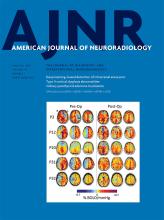Index by author
Bateman, A.R.
- Adult BrainOpen AccessDifferences in the Calculated Transvenous Pressure Drop between Chronic Hydrocephalus and Idiopathic Intracranial HypertensionG.A. Bateman and A.R. BatemanAmerican Journal of Neuroradiology January 2019, 40 (1) 68-73; DOI: https://doi.org/10.3174/ajnr.A5883
Bateman, G.A.
- Adult BrainOpen AccessDifferences in the Calculated Transvenous Pressure Drop between Chronic Hydrocephalus and Idiopathic Intracranial HypertensionG.A. Bateman and A.R. BatemanAmerican Journal of Neuroradiology January 2019, 40 (1) 68-73; DOI: https://doi.org/10.3174/ajnr.A5883
Bello, J.A.
- EditorialYou have accessWomen Rising to the Top: The Tipping Point for the ASNRC.C. Meltzer, P.C. Sanelli, M.B. Hepp and J.A. BelloAmerican Journal of Neuroradiology January 2019, 40 (1) 2-4; DOI: https://doi.org/10.3174/ajnr.A5893
Bonde, A.
- Adult BrainYou have accessDefining the Normal Dorsal Contour of the Corpus Callosum with TimeK.L. Krause, D. Howard, D.R. Pettersson, S. Elstrott, D. Ross, J.T. Obayashi, R. Barajas, A. Bonde and J.M. PollockAmerican Journal of Neuroradiology January 2019, 40 (1) 86-91; DOI: https://doi.org/10.3174/ajnr.A5886
Borrelli, P.
- EDITOR'S CHOICEAdult BrainOpen AccessDeterminants of Deep Gray Matter Atrophy in Multiple Sclerosis: A Multimodal MRI StudyG. Pontillo, S. Cocozza, R. Lanzillo, C. Russo, M.D. Stasi, C. Paolella, E.A. Vola, C. Criscuolo, P. Borrelli, G. Palma, E. Tedeschi, V.B. Morra, A. Elefante and A. BrunettiAmerican Journal of Neuroradiology January 2019, 40 (1) 99-106; DOI: https://doi.org/10.3174/ajnr.A5915
Seventy-seven patients with MS and 44 healthy controls were enrolled in this cross-sectional study. MR imaging investigation included volumetric, diffusion tensor imaging, perfusion weighted imaging, and Quantitative Susceptibility Mapping analyses. Deep gray matter structures were automatically segmented to obtain volumes and mean values for each MR imaging metric in the thalamus, caudate, putamen, and globus pallidus. Patients with MS showed a multifaceted involvement of the thalamus and basal ganglia, with significant atrophy of all deep gray matter structures. In the relapsing-remitting MS group, WM lesion burden proved to be the main contributor to volume loss for all deep gray matter structures.
Bourcier, R.
- FELLOWS' JOURNAL CLUBAdult BrainYou have accessMRI Quantitative T2* Mapping to Predict Dominant Composition of In Vitro ThrombusR. Bourcier, R. Pautre, M. Mirza, C. Castets, J. Darcourt, J. Labreuche, L. Detraz, H. Desal, J.-M. Serfaty and C. ToquetAmerican Journal of Neuroradiology January 2019, 40 (1) 59-64; DOI: https://doi.org/10.3174/ajnr.A5938
Thirty-five thrombus analogs of different compositions were scanned with an MR imaging quantitative T2* mapping sequence. Two radiologists, blinded to thrombus composition, measured the thrombus-T2* relaxation time twice, at an interval of 2 weeks. Quantitative histologic evaluations of red blood cell content were performed. Inter- and intraobserver reproducibility of the thrombus-T2* relaxation time was assessed by calculating intraclass correlation coefficients. MR imaging quantitative T2* mapping can reliably identify the thrombus red blood cell content in vitro. This fast, easy-to-use sequence could be implemented in routine practice.
- FELLOWS' JOURNAL CLUBAdult BrainYou have accessTwo-Layered Susceptibility Vessel Sign and High Overestimation Ratio on MRI Are Predictive of Cardioembolic StrokeR. Bourcier, I. Derraz, S. Bracard, C. Oppenheim and O. Naggara on behalf of the THRACE InvestigatorsAmerican Journal of Neuroradiology January 2019, 40 (1) 65-67; DOI: https://doi.org/10.3174/ajnr.A5865
Two characteristics of the susceptibility vessel sign, overestimation ratio (overR), a quantitative evaluation of the susceptibility vessel sign, and the 2-layered susceptibility vessel sign (TL-SVS), were reported to predict cardioembolic stroke. These 2 biomarkers, on 1.5T or 3T systems (159 and 101 patients, respectively), demonstrated high specificity (0.77 at 1.5T and 1 at 3T) and their simultaneous presence is highly associated with cardioembolism.
Bracard, S.
- FELLOWS' JOURNAL CLUBAdult BrainYou have accessTwo-Layered Susceptibility Vessel Sign and High Overestimation Ratio on MRI Are Predictive of Cardioembolic StrokeR. Bourcier, I. Derraz, S. Bracard, C. Oppenheim and O. Naggara on behalf of the THRACE InvestigatorsAmerican Journal of Neuroradiology January 2019, 40 (1) 65-67; DOI: https://doi.org/10.3174/ajnr.A5865
Two characteristics of the susceptibility vessel sign, overestimation ratio (overR), a quantitative evaluation of the susceptibility vessel sign, and the 2-layered susceptibility vessel sign (TL-SVS), were reported to predict cardioembolic stroke. These 2 biomarkers, on 1.5T or 3T systems (159 and 101 patients, respectively), demonstrated high specificity (0.77 at 1.5T and 1 at 3T) and their simultaneous presence is highly associated with cardioembolism.
Bresolin, N.
- PediatricsYou have access“Ears of the Lynx” MRI Sign Is Associated with SPG11 and SPG15 Hereditary Spastic ParaplegiaB. Pascual, S.T. de Bot, M.R. Daniels, M.C. França, C. Toro, M. Riverol, P. Hedera, M.T. Bassi, N. Bresolin, B.P. van de Warrenburg, B. Kremer, J. Nicolai, P. Charles, J. Xu, S. Singh, N.J. Patronas, S.H. Fung, M.D. Gregory and J.C. MasdeuAmerican Journal of Neuroradiology January 2019, 40 (1) 199-203; DOI: https://doi.org/10.3174/ajnr.A5935
Brunetti, A.
- EDITOR'S CHOICEAdult BrainOpen AccessDeterminants of Deep Gray Matter Atrophy in Multiple Sclerosis: A Multimodal MRI StudyG. Pontillo, S. Cocozza, R. Lanzillo, C. Russo, M.D. Stasi, C. Paolella, E.A. Vola, C. Criscuolo, P. Borrelli, G. Palma, E. Tedeschi, V.B. Morra, A. Elefante and A. BrunettiAmerican Journal of Neuroradiology January 2019, 40 (1) 99-106; DOI: https://doi.org/10.3174/ajnr.A5915
Seventy-seven patients with MS and 44 healthy controls were enrolled in this cross-sectional study. MR imaging investigation included volumetric, diffusion tensor imaging, perfusion weighted imaging, and Quantitative Susceptibility Mapping analyses. Deep gray matter structures were automatically segmented to obtain volumes and mean values for each MR imaging metric in the thalamus, caudate, putamen, and globus pallidus. Patients with MS showed a multifaceted involvement of the thalamus and basal ganglia, with significant atrophy of all deep gray matter structures. In the relapsing-remitting MS group, WM lesion burden proved to be the main contributor to volume loss for all deep gray matter structures.
Caffo, B.
- Practice PerspectivesYou have accessBias in Neuroradiology Peer Review: Impact of a “Ding” on “Dinging” OthersP. Charkhchi, B. Wang, B. Caffo and D.M. YousemAmerican Journal of Neuroradiology January 2019, 40 (1) 19-24; DOI: https://doi.org/10.3174/ajnr.A5908








